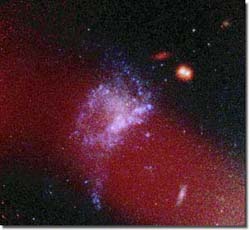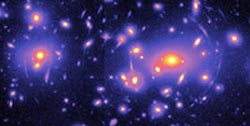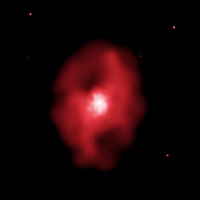Physics and Astronomy
This area deals with the fundamental laws and building blocks of nature and how they interact, the properties and the behavior of matter, and research into space and time and their structures.
innovations-report provides in-depth reports and articles on subjects such as astrophysics, laser technologies, nuclear, quantum, particle and solid-state physics, nanotechnologies, planetary research and findings (Mars, Venus) and developments related to the Hubble Telescope.

Good news from big bad black holes
Astronomers have discovered how ominous black holes can create life in the form of new stars, proving that jet-induced star formation may have played an important role in the formation of galaxies in the early universe.
This false-color image incorporates infrared data (invisible to the human eye). The blue regions (essentially the whole of Minkowski’s Object) show enhanced star formation. The red background galaxy and two red foreground stars appear in sharp contrast. The red over

Spitzer Sees Dusty Aftermath of Pluto-Sized Collision
Astronomers say a dusty disc swirling around the nearby star Vega is bigger than earlier thought. It was probably caused by collisions of objects, perhaps as big as the planet Pluto, up to 2,000 kilometers (about 1,200 miles) in diameter.
NASA’s Spitzer Space Telescope has seen the dusty aftermath of this “run-in.” Astronomers think embryonic planets smashed together, shattered into pieces and repeatedly crashed into other fragments to create ever-finer debris. Vega’s l

Astronomers Discover Cold, Warm and Hot Gas Around a Young Brown Dwarf
A team of scientists from the University of Delaware has discovered that brown dwarfs–celestial bodies that are often referred to as failed stars–can be surrounded by clouds of very hot and very cool gas.
The UD research team of John E. Gizis, assistant professor of physics and astronomy, Harry L. Shipman, Annie Jump Cannon Chair of Physics and Astronomy, and James A. “Rusty” Harvin, researcher in physics and astronomy, used the Hubble Space Telescope to show for the first time

Substructure maps show that dark matter clumps in galaxies
Hubble Space Telescope data, analyzed by a Yale astronomer using gravitational lensing techniques, has generated a spatial map demonstrating the clumped substructure of dark matter inside clusters of galaxies.
Clusters of galaxies (about a million, million times the mass of our sun), are typically made up of hundreds of galaxies bound together by gravity. About 90 percent of their mass is dark matter. The rest is ordinary atoms in the form of hot gas and stars.
Althou

The dynamo in the Cornfield
To understand our planet’s magnetic field, Wisconsin scientists are studying a ball of molten metal
In an underground bunker that brushes up against a barnyard on one side and a cornfield on the other, scientists from the University of Wisconsin, Madison, are trying to solve an enduring cosmic mystery: how does the Earth generate its magnetic field–the vast, invisible web that shapes the aurora, makes compass needles point north, and shields us from solar storms? And how do simi

Most powerful eruption in the universe discovered
Astronomers have found the most powerful eruption in the universe using NASA’s Chandra X-ray Observatory. A super massive black hole generated this eruption by growing at a remarkable rate. This discovery shows the enormous appetite of large black holes, and the profound impact they have on their surroundings.
The huge eruption was seen in a Chandra image of the hot, X-ray emitting gas of a galaxy cluster called MS 0735.6+7421. Two vast cavities extend away from the super mas